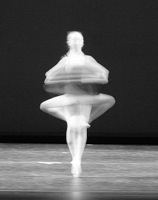Difference between revisions of "Pirouette"
m (Text replacement - "http://" to "https://") |
|||
| Line 3: | Line 3: | ||
==Origin== | ==Origin== | ||
French, [[literally]], teetotum | French, [[literally]], teetotum | ||
| − | *[ | + | *[https://en.wikipedia.org/wiki/18th_century 1706] |
==Definition== | ==Definition== | ||
| − | *1: a rapid whirling about of the [[body]]; especially : a full turn on the toe or ball of one foot in [ | + | *1: a rapid whirling about of the [[body]]; especially : a full turn on the toe or ball of one foot in [https://en.wikipedia.org/wiki/Ballet ballet] |
==Description== | ==Description== | ||
| − | '''Pirouette''' means to "turn". In ballet, it is a controlled turn on one leg, starting with one or both legs in ''plié'' and rising onto ''Relevé'' (usually for [[men]]) or ''pointe'' (usually for [[women]]). The non-supporting leg is be held in ''Passé''.The pirouette may return to the starting [[position]] or finish in arabesque or [[attitude]] positions, or proceed otherwise. A pirouette is most often en dehors turning outwards toward the back leg, but can also be [ | + | '''Pirouette''' means to "turn". In ballet, it is a controlled turn on one leg, starting with one or both legs in ''plié'' and rising onto ''Relevé'' (usually for [[men]]) or ''pointe'' (usually for [[women]]). The non-supporting leg is be held in ''Passé''.The pirouette may return to the starting [[position]] or finish in arabesque or [[attitude]] positions, or proceed otherwise. A pirouette is most often en dehors turning outwards toward the back leg, but can also be [https://en.wikipedia.org/wiki/Pirouette#En_dehors en dedans] turning inwards toward the front leg. Although ballet pirouettes are performed with the hips and legs rotated outward ("turned out"), it is common to see them performed with an inward rotation ("parallel") in other [[genres]] of dance, such as jazz and modern. |
| − | Turning [[technique]] includes [ | + | Turning [[technique]] includes [https://en.wikipedia.org/wiki/Spotting_(dance_technique) spotting], in which a dancer executes a periodic, rapid [[rotation]] of the head that serves to fix the dancer's gaze on a single spot. Spotting is particularly important in traveling turns such as [https://en.wikipedia.org/wiki/Cha%C3%AEn%C3%A9s tours chaînés] or [https://en.wikipedia.org/wiki/Piqu%C3%A9 piqués] because it helps the dancer [[control]] the direction of travel while keeping [[balanced]]. Otherwise, pirouettes can be executed with a single or multiple rotations. |
[[Category: Dance]] | [[Category: Dance]] | ||
Latest revision as of 02:32, 13 December 2020
Origin
French, literally, teetotum
Definition
- 1: a rapid whirling about of the body; especially : a full turn on the toe or ball of one foot in ballet
Description
Pirouette means to "turn". In ballet, it is a controlled turn on one leg, starting with one or both legs in plié and rising onto Relevé (usually for men) or pointe (usually for women). The non-supporting leg is be held in Passé.The pirouette may return to the starting position or finish in arabesque or attitude positions, or proceed otherwise. A pirouette is most often en dehors turning outwards toward the back leg, but can also be en dedans turning inwards toward the front leg. Although ballet pirouettes are performed with the hips and legs rotated outward ("turned out"), it is common to see them performed with an inward rotation ("parallel") in other genres of dance, such as jazz and modern.
Turning technique includes spotting, in which a dancer executes a periodic, rapid rotation of the head that serves to fix the dancer's gaze on a single spot. Spotting is particularly important in traveling turns such as tours chaînés or piqués because it helps the dancer control the direction of travel while keeping balanced. Otherwise, pirouettes can be executed with a single or multiple rotations.
